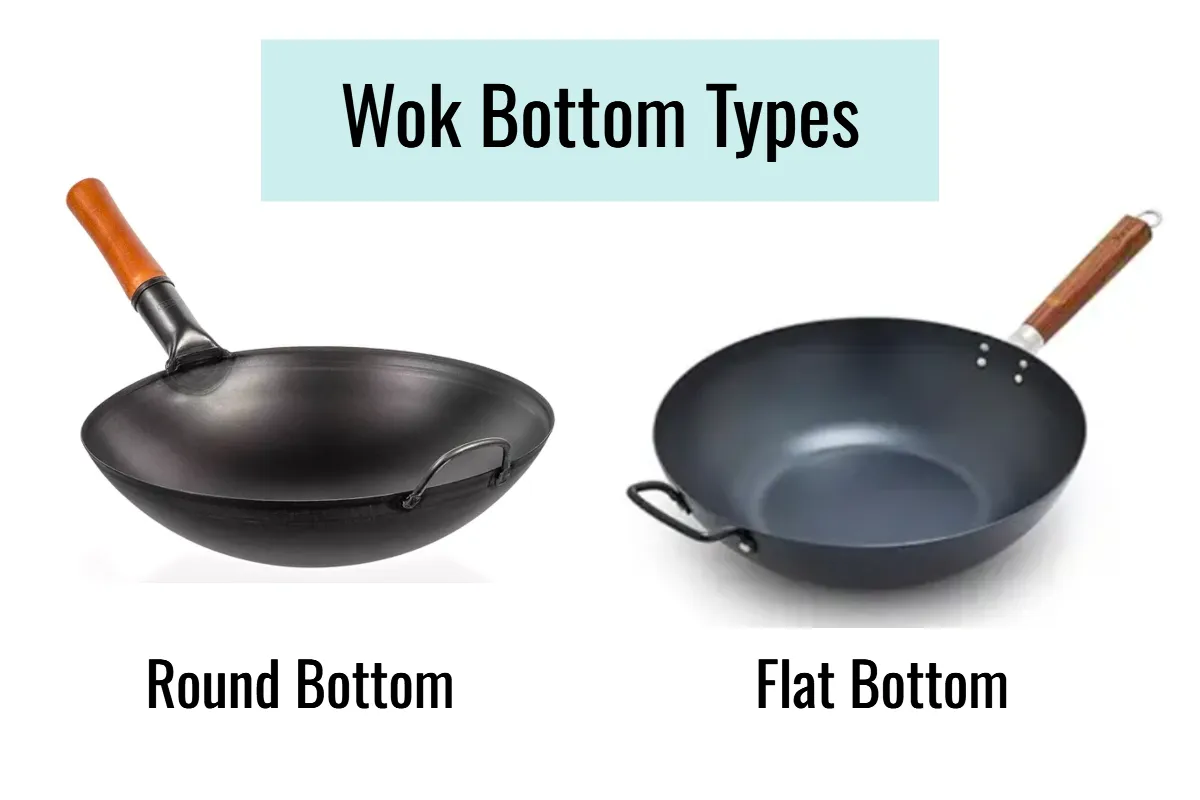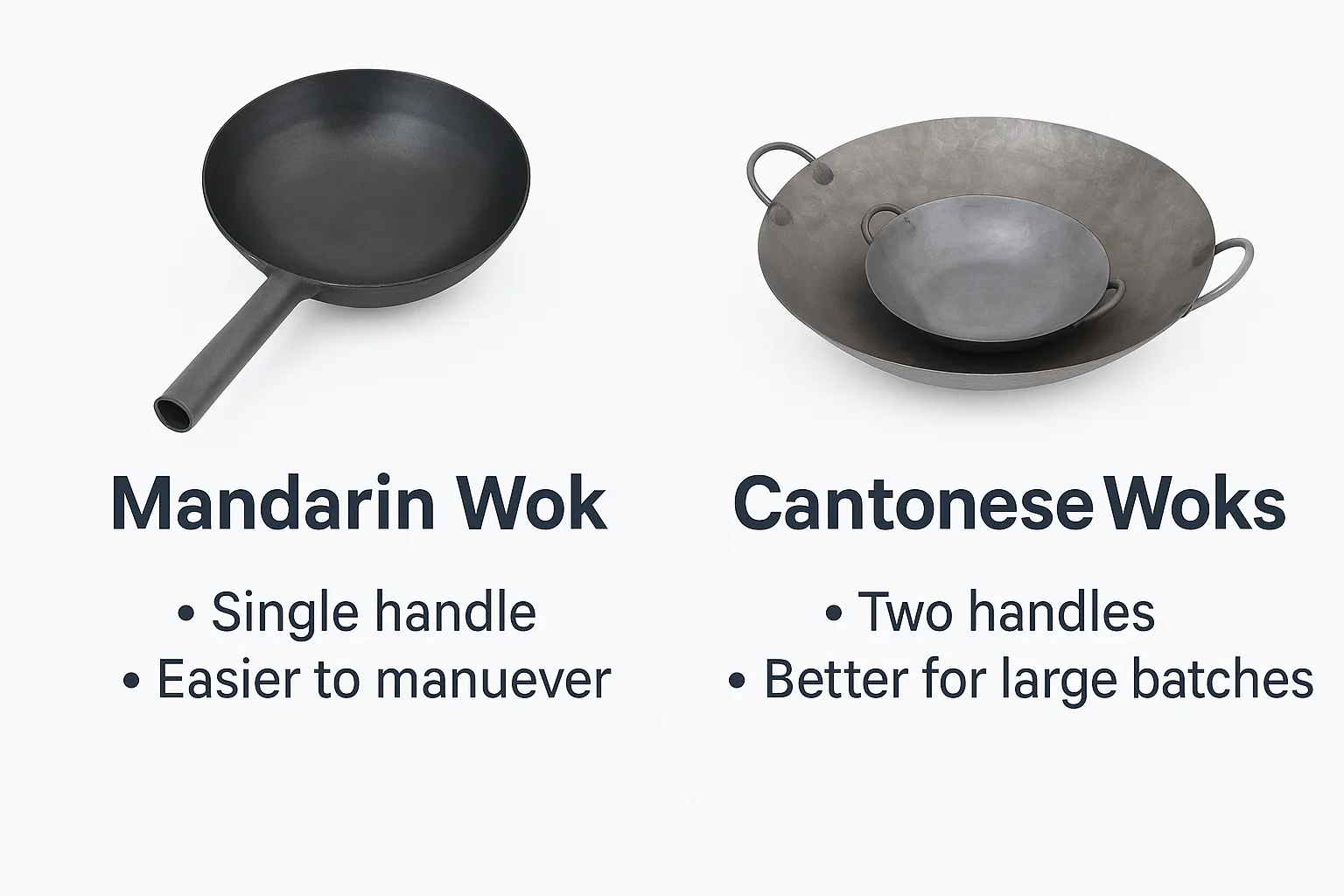The Ultimate Wok Buying Guide: Shape, Size, and Handle Styles Explained
The Ultimate Wok Buying Guide: Shape, Size, and Handle Styles Explained
 Two woks side by side showing bottom shape differences
Two woks side by side showing bottom shape differences
For the amateur cook, selecting a wok can be a daunting task. The market is filled with variations in shape, handle style, and size. Understanding the functional implications of these design choices is the first and most critical step in acquiring a tool that will serve, rather than frustrate, your culinary ambitions. The most significant decision is the shape of the bottom, a choice that represents a fundamental compromise between tradition and modern convenience.
Buying Reality: The "best" wok doesn't exist in absolute terms. The ideal wok for you depends entirely on your stove type, cooking style, and kitchen setup. This guide will help you match the right wok to your specific needs.
After choosing your wok, optimize your kitchen setup for maximum performance. Understanding why carbon steel excels helps inform your buying decision.
Bottoms Up: The Great Debate of Flat vs. Round
The choice between a flat-bottomed and a round-bottomed wok is dictated almost entirely by the type of stove in your kitchen. This decision will fundamentally affect your cooking experience and results.
The Traditionalist: Round-Bottom Wok
The original wok design features a perfectly curved, round bottom. This shape is the ideal match for a traditional high-output wok burner or a powerful gas stove, where flames can lick up the sides of the pan. This creates a gradient of distinct heat zones: an intensely hot area at the very bottom for searing, and progressively cooler zones up the sloped sides for gentler cooking or holding ingredients.
Heat Zone Benefits: The round bottom creates natural temperature gradients that allow you to sear proteins in the center while keeping vegetables warm on the sides - all in the same pan simultaneously.
This classic shape enables the seamless, circular tossing motion—a flick of the wrist that sends food cascading through the different heat zones—which is essential for authentic stir-frying.
However, this traditional design has significant limitations:
- Fundamentally incompatible with flat surfaces of Western electric, induction, or ceramic cooktops
- Wobbles precariously without support
- Requires a separate wok ring accessory for stability on most gas stoves
- Smaller direct contact area with heat source
Traditional Context: Round-bottom woks were designed for Chinese pit-style stoves (zào) where the wok nestled directly into the fire opening. Modern Western stoves require adaptation.
The Modern Adaptation: Flat-Bottom Wok
The flat-bottomed wok is a modern innovation designed specifically for the Western kitchen and is the most popular choice for home cooks. Its key advantage is universal compatibility - it sits securely on any flat cooktop, including gas, electric, and induction, without the need for additional accessories.
Key Advantages:
- Stability: Sits securely on any flat surface
- Larger searing area: Flat base provides more direct contact with heat
- No accessories needed: Works immediately on any stove
- Easier storage: Stacks with other flat-bottom cookware
Performance Trade-off: While convenient, the flat bottom concentrates heat intensely in one spot, which can lead to hot spots and requires careful heat management.
The Compromise: This convenience comes with a performance trade-off. The flat bottom concentrates heat intensely in one spot, which can lead to burning if not managed carefully, especially on a powerful gas burner. More importantly, the angular transition from the flat bottom to the sloped sides disrupts the smooth, fluid tossing motion possible with a round-bottomed wok.
Handle Styles: Mandarin vs. Cantonese
 Two woks showing different handle configurations side by side
Two woks showing different handle configurations side by side
Wok handles come in two primary styles, each suited to different cooking actions and preferences.
Mandarin/Pow Wok (Northern Style)
Also known as a Northern-style wok, this design features a single long handle, typically made of wood or metal, much like a Western skillet. This is the style most experts recommend for home use.
Advantages:
- Excellent leverage: Perfect for the tossing and flipping motion known as pao
- Intuitive handling: Familiar to Western cooks
- Safety: Keeps hands away from heat source
- Dynamic cooking: Ideal for single-portion stir-frying with lots of movement
Technique Tip: The long handle allows for the classic "pao" motion - a quick wrist flick that tosses ingredients up and over in the wok. This technique is essential for authentic stir-frying.
Best for:
- Home cooks new to wok cooking
- Single-portion cooking
- Active stir-frying techniques
- Limited storage space
Cantonese Wok (Southern Style)
Also known as a Southern Chinese wok, this design has two small, U-shaped loop handles (sometimes called "pig ear" handles) riveted to opposite sides of the pan.
Key Characteristics:
- Not for tossing: This style is not designed for the dramatic food-flipping motion
- Lifting and carrying: The two handles make it easier to lift and carry when full
- High-capacity cooking: Better for large batches and family-style cooking
- Versatile functions: Excellent for steaming, deep-frying, and braising
Cultural Context: The Cantonese style reflects Southern Chinese cooking traditions focused on feeding large families and using the wok for multiple cooking methods beyond stir-frying.
Best for:
- Large batch cooking
- Multi-purpose use (steaming, braising, deep-frying)
- Experienced cooks comfortable with different techniques
- Traditional cooking methods
Size and Scale: Finding the Goldilocks Zone
 Three woks of different sizes arranged to show scale differences
Three woks of different sizes arranged to show scale differences
For the vast majority of home kitchens, a 14-inch diameter wok is the undisputed standard. This size strikes the perfect balance between capacity and manageability.
The 14-Inch Sweet Spot
Why 14 inches is ideal:
- Optimal capacity: Large enough to cook for 2-4 people without overcrowding
- Heat efficiency: Can be heated effectively by standard home stove burners
- Manageable weight: Not too heavy for comfortable handling
- Storage friendly: Fits in most kitchen cabinets and storage areas
Overcrowding Problem: A common mistake is cramming too much food into a small wok. This causes ingredients to steam rather than fry, preventing proper browning and texture development.
Alternative Sizes
12-Inch Wok:
- Best for: Single-person households, small batches, deep-frying
- Advantages: Heats more evenly on smaller burners, lighter weight
- Limitations: Limited capacity, frequent small-batch cooking required
16-Inch Wok:
- Best for: Large families, batch cooking, powerful burners
- Advantages: Large capacity, impressive for entertaining
- Limitations: Requires very powerful burner, heavy when full, storage challenges
Professional Insight: Restaurant kitchens often use 16-18 inch woks because they have the BTU power to heat them effectively. Home cooks should be realistic about their stove's capabilities.
The Complete Comparison: Round vs. Flat Bottom
 Infographic chart comparing wok bottom types and features
Infographic chart comparing wok bottom types and features
| Feature | Round-Bottom Wok | Flat-Bottom Wok |
|---|---|---|
| Stove Compatibility | Gas stoves (with wok ring), dedicated wok burners. Not suitable for electric or induction. | Gas, electric, induction, ceramic. Universally compatible. |
| Stability | Unstable on its own; requires a wok ring for support on most stoves. | Stable on any flat surface. |
| Heat Profile | Excellent heat distribution up the sides, creating distinct heat zones. | Heat is concentrated on the flat bottom; sides are cooler. Can lead to hot spots. |
| Tossing/Flipping | Enables a seamless, circular tossing motion, ideal for authentic stir-frying. | The angular transition from bottom to sides hinders the classic tossing motion. |
| Searing Surface | Very small, concentrated searing area at the direct bottom. | Larger flat surface area for searing multiple items at once. |
| Authenticity | The traditional, authentic design for classic wok cooking techniques. | A modern adaptation that compromises some traditional function for convenience. |
| Accessories | Requires a wok ring for use on most home gas stoves. | Requires no special accessories for stability. |
| Learning Curve | Higher - requires mastering heat zones and tossing techniques | Lower - more intuitive for Western cooks |
| Versatility | Excellent for traditional Chinese techniques | Better for Western-style cooking adaptations |
Making Your Decision: A Practical Framework
Step 1: Assess Your Stove Type
- Gas stove: Either round or flat-bottom will work
- Electric/Induction: Flat-bottom is mandatory
- Outdoor/High-BTU: Round-bottom is optimal
Step 2: Consider Your Cooking Style
- Traditional stir-frying: Round-bottom preferred
- Mixed cooking methods: Flat-bottom more versatile
- Large batch cooking: Consider Cantonese handle style
- Single servings: Mandarin handle style recommended
Step 3: Evaluate Your Experience Level
- Beginner: Start with flat-bottom, Mandarin handle
- Intermediate: Either style based on stove type
- Advanced: Round-bottom for authentic techniques
Step 4: Factor in Practical Considerations
- Storage space: Flat-bottom stacks better
- Budget: Flat-bottom typically less expensive (no ring needed)
- Frequency of use: More frequent use justifies traditional round-bottom
Common Buying Mistakes to Avoid
Size Mistakes
- Too small: Constantly cooking in tiny batches
- Too large: Can't heat effectively, becomes unwieldy
- Wrong proportion: Wok too big for burner size
Shape Mistakes
- Round on electric: Won't heat properly, unstable
- Flat on high-BTU: Doesn't take advantage of flame coverage
- Ignoring stove type: Compatibility should be the primary factor
Handle Mistakes
- Wrong style for use: Cantonese handles for dynamic stir-frying
- Poor construction: Weak attachment points that fail over time
- Material issues: Metal handles that get too hot
Regional Preferences and Recommendations
American Market
- Most popular: 14-inch flat-bottom with Mandarin handle
- Reasoning: Matches typical home kitchen setup
- Brands: Joyce Chen, Yosukata, Mammafong
European Market
- Preference: Smaller sizes (12-13 inch) due to smaller stoves
- Style: Flat-bottom for induction compatibility
- Focus: Multi-purpose use beyond stir-frying
Asian Markets
- Traditional: Round-bottom still preferred
- Size: Often larger (16+ inch) for family cooking
- Handles: Mix of both styles depending on region
The Bottom Line: Our Recommendations
Best for Most Home Cooks:
14-inch, flat-bottom, carbon steel wok with Mandarin handle
- Universal compatibility
- Manageable size
- Intuitive handling
- Best value for versatility
Best for Gas Stove Enthusiasts:
14-inch, round-bottom, carbon steel wok with Mandarin handle + wok ring
- Authentic cooking experience
- Superior heat distribution
- Traditional techniques possible
- Investment in proper equipment
Best for Large Families:
16-inch, flat-bottom, carbon steel wok with Cantonese handles
- High capacity
- Stable for large batches
- Easy to lift when full
- Multi-purpose cooking
The right wok enables proper cooking techniques and authentic results. The key to selecting the right wok lies in honest assessment of your cooking environment, experience level, and culinary goals. There's no single "perfect" wok, but there is a perfect wok for your specific situation. By understanding the trade-offs between different designs, you can make an informed decision that will serve you well for years to come.
This article is part of our comprehensive wok cooking series. Next: "Wok Materials Decoded: Carbon Steel vs. Cast Iron vs. Stainless Steel vs. Non-Stick"
Comments
Post a Comment